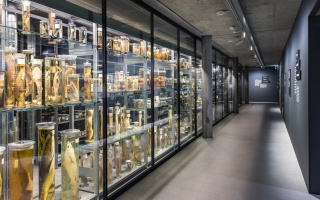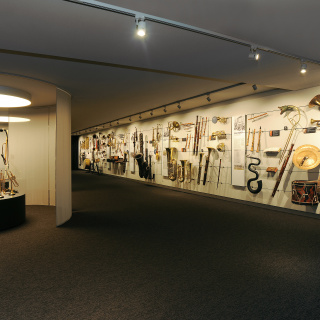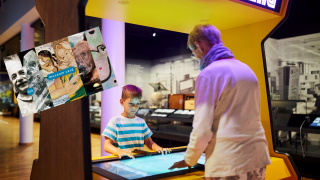
Barry - the legendary St. Bernard
Barry, the legendary St. Bernard, is probably the museum’s most famous exhibit. The loyal rescue dog lived over 200 years ago in a hospice on the Great St. Bernard Pass and was involved in many mountain rescues. In 2014, Barry’s heroic acts were honored with his own permanent exhibition – including a golden display cabinet.
Historical Animal Diorama

In some 220 elaborate displays, so-called dioramas, the museum presents an exciting array of mammals and birds in their natural habitats. The appealing exhibitions takes visitors on a journey through Africa, Asia, Alaska, and the Swiss Alps. You’ll encounter everything that flies, crawls, swims, or walks – from lions, gorillas and gazelles to ibexes, rock ptarmigans and little owls to polar bears and seals.
Modern multimedia information puts the “3D picture books” in perspective and makes their historical dimension visible. Among other things, the Africa Collection addresses “exhibits from the colonial context”, a very present topic throughout the museum.
Discover the Cabinet of Curiosities
With its permanent exhibition “Cabinet of Curiosities – The display collection”, the museum is opening its scientific collections to the public. A walk through the exhibition provides insight into the museum’s current collection activities, modern research methods, and priceless historical collections.
There’s an incredible variety of invertebrates at the Natural History Museum Bern – beautiful beetles are displayed next to colourful butterflies and rare shells next to exotic snails and ancient fossils.

Meteorites, Giant Crystals and Diamonds
The basement level introduces visitors to a tremendous collection of minerals. The impressive and sensationally clear giant crystals from the Planggenstock mountain never fail to attract attention. Discovered in 2005 by two rock crystal hunters, Franz von Arx and Paul von Känel, today they sparkle and shine in the “Treasure Chamber” of the Natural History Museum. The crowning jewel of the exhibition is the uniquely structured, 300-kilogram group of crystals, which slowly revolves around its own axis.
Explore the museum
Children are free to explore the different exhibition rooms of the museum, equipped with one of the free adventurer’s cases available for families. With tricky puzzles, fun matching games and your very own exhibits, the visit quickly becomes an entertaining research experience.
For older children, a lab awaits on the 2nd floor, where interactive stations, some of them supervised, give an individual and in-depth introduction to nature and its cycles. And in the Geo Lab one floor up, children can conduct exciting experiments and learn everything there is to know about minerals, rocks, and fossils.
-
Admission
Adults CHF 12.00 Students, AHV/IV pensioners, groups of 10 or more CHF 10.00 Members of the Natural History Museum Association CHF 4.00 Kids and youth (16 years & under), schools Admission free
You might also like
-
 Meetings & Kongresse > Darum BernShoppingMore
Meetings & Kongresse > Darum BernShoppingMore -
 Art & Culture, Families & Kids, Meetings & Kongresse > Darum BernPlaying MuseumMore
Art & Culture, Families & Kids, Meetings & Kongresse > Darum BernPlaying MuseumMore -
 Meetings & Congress > Social Programs, Meetings & Kongresse > Darum Bern, Meetings & Kongresse > Darum BernChocolate Workshop with the Chocolate World ChampionsMore
Meetings & Congress > Social Programs, Meetings & Kongresse > Darum Bern, Meetings & Kongresse > Darum BernChocolate Workshop with the Chocolate World ChampionsMore -
 Attractions, Activitäten > Ausflüge, Families & KidsThe Aare RiverMore
Attractions, Activitäten > Ausflüge, Families & KidsThe Aare RiverMore


